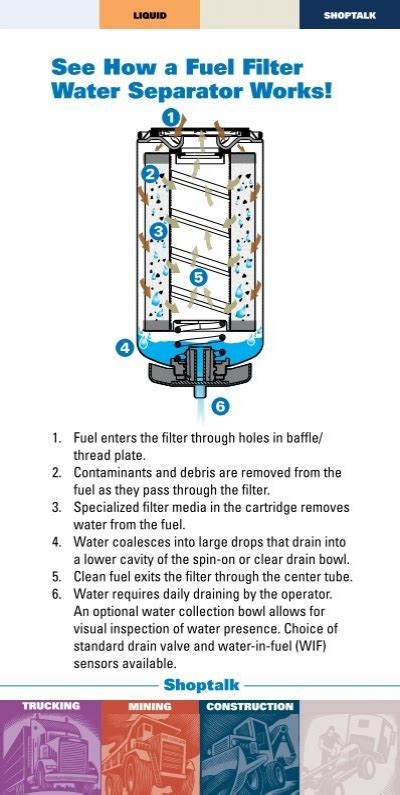How A Fuel Water Separator Works
Ronan Farrow
Apr 03, 2025 · 3 min read

Table of Contents
How a Fuel Water Separator Works: A Comprehensive Guide
Fuel contamination is a serious issue that can severely damage your engine. Water, in particular, is a common contaminant that can lead to corrosion, fuel injector clogging, and ultimately, engine failure. This is where a fuel water separator comes in, playing a crucial role in protecting your engine's health and longevity. This guide will walk you through the inner workings of a fuel water separator, explaining how it effectively removes water and other contaminants from your fuel system.
Understanding the Problem: Water in Fuel
Before diving into the mechanics of a separator, let's understand why water is such a significant threat to your engine. Water in fuel can cause several problems:
- Corrosion: Water accelerates corrosion in fuel tanks, fuel lines, and engine components, leading to premature wear and tear.
- Microbial Growth: Water provides an ideal breeding ground for microorganisms that can clog fuel filters and injectors.
- Reduced Fuel Efficiency: Water can interfere with the combustion process, resulting in reduced engine performance and fuel economy.
- Engine Damage: Severe water contamination can lead to engine stalling, misfires, and even catastrophic engine failure.
How a Fuel Water Separator Works: The Science Behind the Separation
Fuel water separators employ various methods to remove water from fuel. The most common types utilize coalescence and gravity. Let's break down the process:
1. Coalescence: Bringing Small Water Droplets Together
Fuel often contains tiny water droplets dispersed throughout the fuel. These are too small to be effectively separated by gravity alone. The separator utilizes a coalescing element, usually a specialized filter media, to bring these small droplets together into larger, heavier droplets. This element is often made of materials like specialized fibers or porous media that encourage water droplets to adhere to its surface.
2. Gravity Separation: Water Sinks, Fuel Rises
Once the water droplets have coalesced into larger drops, gravity takes over. The separator is designed with a bowl or chamber where the heavier water settles to the bottom, while the cleaner fuel remains on top. This relies on the difference in density between water and fuel – water is denser and therefore sinks.
3. Draining the Water
Most fuel water separators have a drain valve at the bottom of the water collection chamber. This allows you to periodically drain accumulated water, ensuring the continued effectiveness of the separator. Regularly checking and draining this water is crucial for maintaining optimal performance.
Types of Fuel Water Separators
While the fundamental principle remains the same, fuel water separators come in different designs:
- Spin-on style: These are typically installed inline and replaced as a unit when the filter element becomes saturated. They are simple to install and maintain.
- Bowl-type: These have a larger water collection bowl that can be easily accessed for draining. They offer greater water holding capacity.
- Combination units: Some units combine filtration for particulate matter with water separation.
Maintaining Your Fuel Water Separator
Proper maintenance is essential to ensure the longevity and effectiveness of your fuel water separator:
- Regular Water Draining: Check and drain the water regularly, as recommended by the manufacturer. The frequency depends on the usage and quality of the fuel.
- Filter Element Replacement: Replace the filter element according to the manufacturer's recommendations. A clogged filter element reduces the separator's efficiency.
- Visual Inspection: Periodically inspect the separator for any signs of damage or leaks.
Conclusion: Protecting Your Engine Investment
A fuel water separator is a crucial component in protecting your engine from the damaging effects of water contamination. By understanding how it works and performing regular maintenance, you can significantly extend the life of your engine and avoid costly repairs. Investing in a quality fuel water separator is a smart investment that safeguards your equipment and ensures smooth, reliable operation.
Featured Posts
Also read the following articles
| Article Title | Date |
|---|---|
| Howa 1500 Trigger Replacement | Apr 03, 2025 |
| Brisket In Cooler How Long | Apr 03, 2025 |
| How To Winterize A Water Heater | Apr 03, 2025 |
| How Big Is A Dunkin Medium Iced Coffee | Apr 03, 2025 |
| How Are Little League All Stars Chosen | Apr 03, 2025 |
Latest Posts
Thank you for visiting our website which covers about How A Fuel Water Separator Works . We hope the information provided has been useful to you. Feel free to contact us if you have any questions or need further assistance. See you next time and don't miss to bookmark.
